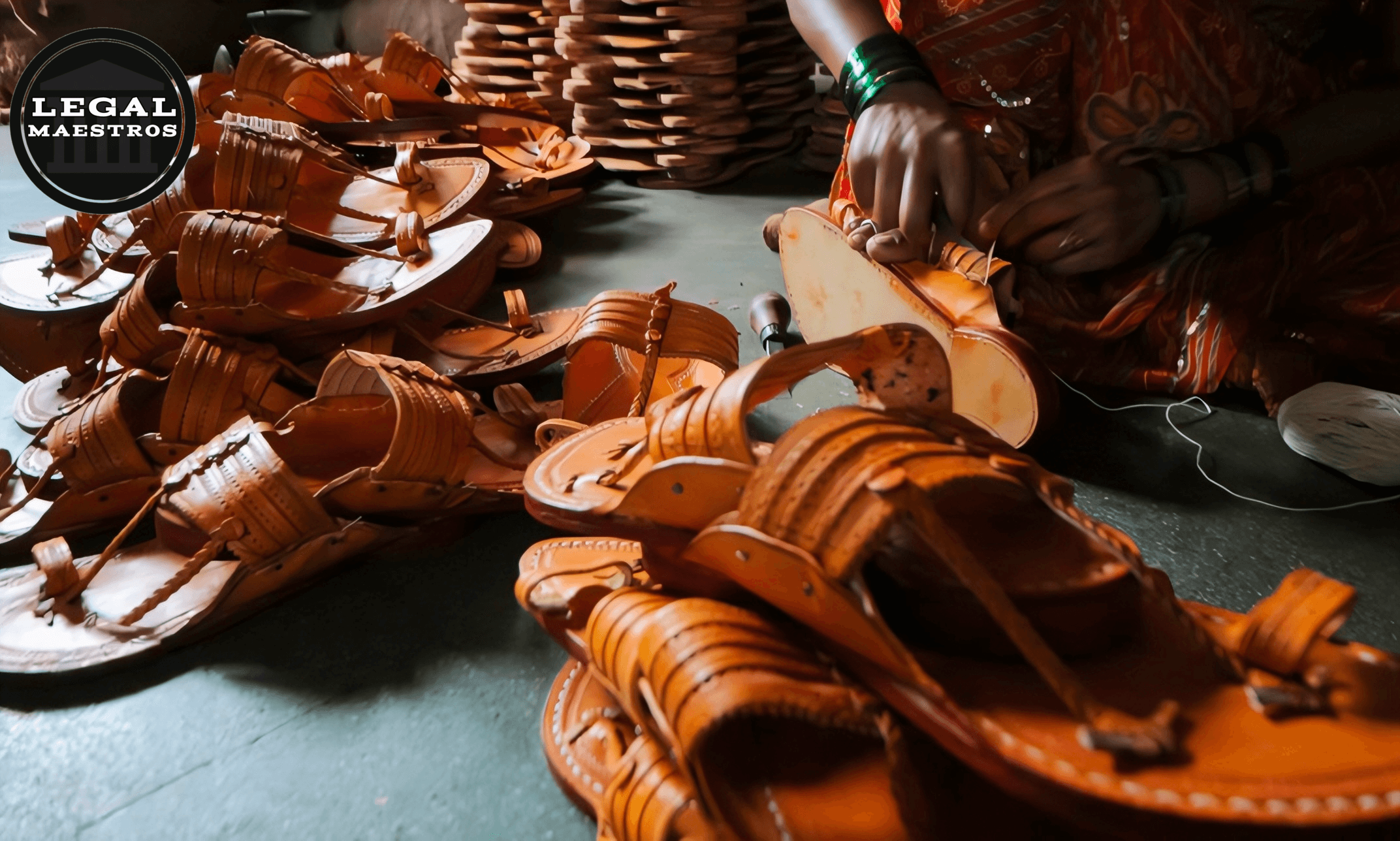
In a major turn of events, Prada, the Italian high-fashion brand has been sued in the Bombay High Court through Public Interest Litigation (PIL) by an enraged citizen who has accused the brand of openly plagiarizing the Indian Kolhapuri chappals in their newly promoted range of exorbitantly priced toe-ring sandals. It is a legal challenge led by a group of 6 advocates led by Ganesh Hingmire, which aims at safeguarding the cultural icon of Maharashtra and the livelihood of lakhs of artisans who have carefully handcrafted these handcrafted leather sandals over close to 8 centuries. The PIL brings out the aspect of the confluence of Intellectual property rights (IPR) with traditional knowledge and the sustainability of public interest litigation with regard to the preservation of Indian heritage.
Matter of the Heart: Kolhapuri Chapels and so-called Appropriation
Kolhapuri chatpal is not only a walking shoe, it is the creation of decades of talented artisans that tells a story, just as the culture from which it emerged is embedded in the land of Maharashtra and portions of Karnataka. The Kolhapuri chatpal was also given a Geographical Indication (GI) tag in 2009 and its registration has been renewed and its validity is till 2029. This GI tag is a legal recognition given that the product is geographically grown and has a certain position or quality affiliated to its source.
Prada, being one of the world renowned fashion giants, has recently launched its Spring/Summer 2026 Men collection at Milan fashion week with its shoes (sandals) that were known to be made of ring in their toes being called toe-ring sandals that are supposedly 1000+ per pair. The PIL traces that these sandals are pretentious and similar to the Kolhapuri chappal. More importantly, the petition notes that Prada had not in the first place indicated that there was an Indian influence on the collection, but it had finally acknowledged this internally whenever there was a big outcry on social media. This tardy and in secrecy recognition as per the petitioners, only amounts to a superficial move to ward off criticism and is short of a formal public apology and a payout that is due to the Kolhapuri artisans.
For any queries or to publish an article or post or advertisement on our platform, do call at +91 6377460764 or email us at contact@legalmaestros.com.
The essence of the argument put forth by the petitioners is that permission granted by Prada to use and exploit a GI tagged product such as the Kolhapuri chappal amounts to violation of intellectual property rights. They argue that this not only leads to an “erosion of the GI identity” as well as creating a situation of dilution of the GI identity but it also results in an unfair enrichment of the foreign brand at the expense of the artisans who are denied any right to any accruing economic or reputational value. The PIL brings out the helplessness of the artisan community who do not have the required finances, government backing, and knowledge of their rights as a community to file legal cases with, against, the large international firms.
What is Public Interest Litigation (PIL) about?
Public Interest Litigation (PIL) involves the institution of a case in a court of law to achieve the common good. Contrary to conventional litigation where the subject of the remedy is the immediate or denied party involved in a transaction or undertaking, a PIL may be instituted by any man with a good conscience or society which includes matters pertaining to the legal rights of society or the common people in general.
The idea of PIL rose to importance in India during the 1980s, thanks to the endeavours of Justices P.N. Bhagwati and V.R. Krishna Iyer. It marks a strong departure from the strict principle of locus standi, which needed a direct personal interest in the case. This was an innovation to provide justice to those marginalized and less privileged groups in society who were not fully equipped in terms of resources as well as that of awareness to reach out to the courts themselves. Indian constitution supports PILs both in the Supreme Court through Article 32 and in the High Courts under Article 226.
Is PIL (in this case) sustainable?
The viability of PIL in issues surrounding intellectual property, especially traditional knowledge is not a simple matter that has all its benefits but rather a complex issue.
PIL Inventions in the matter of IPR as well as Traditional Knowledge:
Right to Justice for the Unprivileged: On the one hand, the artisan communities that benefit are under the overshadowing shadow of the international giants and do not have the financial capabilities or the legal skills to gain access to justice and hence they are left at the mercy of huge foreign corporations. PIL is an indispensable means through which these communities can achieve collective power in terms of pursuing justice and claiming their rights.
Advocating Systemic Reasons: PILs are not just individual grievances; moreover, they express more substantial issues of systemic flaws with cultural appropriation, unfair business cases, and the misuse of indigenous knowledge around the globe above international brands. This can instigate the policy making changes and escalate government participation.
Establishment of legal precedents: Positive PILs can also establish overwhelmingly important legal precedents that make it undesirable to repeat the offense of cultural misappropriation, and create a more formidable legal force to resolving cultural misappropriation.
Raising public awareness and advocacy: PIL usually attracts a lot of media coverage and a debate in society and creates awareness regarding the need to safeguard traditional crafts and the rights of the creators of those crafts. Such public pressure can play a key role in having positive results.
Judicial Activism as a means of Social Justice: The Indian judiciary has in the past been seen to be quite active in employing PILs to correct social wrongs and protect basic rights. In this way, judicial activism may be an effective tool in culture protection.
Challenges List of Challenges to Sustainability:
Overstraining the Courts: The growing trend in PILs which may be frivolous cases, may overemphasize the already burdened judicial bodies and this may possibly hold up the true public interest proceedings.
Absence of Specific Legal Framework on Traditional Knowledge: Though the GI tags provide some form of protection, the legal framework for a large-scale protection of traditional knowledge against improper claims in globally assigned situations still lacks the proper development. This may mean that it is hard to present complex situations to the court based on the IP laws in place only.
Problems of Enforcement: Just in case a favorable judgment is given, it may cause a hard challenge to enforce it against an international corporation such as Prada, especially when it is a matter of global sales and distribution.
Legal definition and Proof of the concept of Cultural Appropriation: Defining and proving the legal concept of cultural appropriation may be difficult to understand considering the factors between inspiration, imitation, and economic exploitation.
Resource Tasking: The first filing can be less resource consuming than single litigation, however, long term kind of litigation involving complex international situations of IPRs can be resource consuming even to one with high social considerations.
Irrespective of these issues it is important to note that the Kolhapuri chappal PIL showed the vital role that PIL may have regarding intellectual property.ssues involving traditional knowledge. It gives voice to those who are voiceless and serves as a tool of the accountability of the powerful entities.
IPR Angle: Conserving the Traditional Knowledge: IP Angle: Conserving the Traditional Knowledge
The case is a strong testimony to the weaknesses and opportunities of Intellectual Property Rights (IPR) in safeguarding traditional knowledge.
Geographical Indications (GI): A very important component of the argument presented in the PIL is the GI tag of the Kolhapuri chappal. GI tags protect those products of particular geographical origin and possess qualities or reputation as a result of their geographical place. Their main idea is to ward off incidents of the unauthorized use of the registered name and that the economic benefits of the property be within the community of the designated geographical space. Under the PIL, the protection that is supposed to be enforced against misuse by Prada is sought.
Problems of Conventional IPR: Conventional forms of IPR such as patents, copyright and trademarks are indeed effective in protecting individual inventions, but for the protection of traditional knowledge, they may not work. Patents are about novelty and inventiveness and traditional knowledge, which is ancient and is often oral, rarely satisfies those requirements. Copyright applies to expressions rather than ideas and there may be a problem with individual attribution where traditional knowledge is communally owned. Trademarks generally safeguard logos, as well as brand names, which is not always particularly applicable to the native form of a craft, or its traditional cultural value.
The Need for Sui Generis Systems: The case brings up the issue of the existing debate world over about whether there is a necessity for sui generis (unique) legal systems especially designed to safeguard traditional knowledge. Such systems would have the ability to deal with the collective nature of the ownership of traditional knowledge, the inter-generational flow of the traditional knowledge, and the changing nature of the traditional knowledge and would be able to afford better protection than other IPR systems that are currently in place. India has been successful in this field through initiatives such as the Traditional Knowledge Digital Library (TKDL) which creates a prior art library to help stop improper granting of patents on traditional knowledge. Nevertheless, a strong international system is yet to be presented.
Benefit Sharing and recognition: In addition to the legality of the injunction, the awarding of compensation and apology in public view is a demonstration by the PIL of more proportional benefit sharing and fair treatment of the holders of traditional knowledge. This plays a very important role in ethical practice regarding intellectual property and preservation of culture.
The thin line between Inspiration and Appropriation: The case also raises such issues as the thin line between inspiration and appropriation. Although cross-cultural exchange and inspiration are essential to creativity, appropriation happens when aspects of a culture are stolen and employed by members of another culture, either without knowledge, esteem, or recognition of the original setting, and usually to commercial advantage, especially when the original community is a disadvantaged one.





